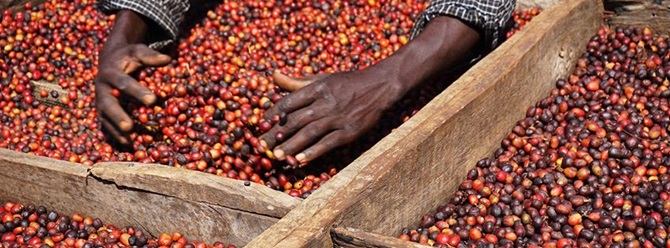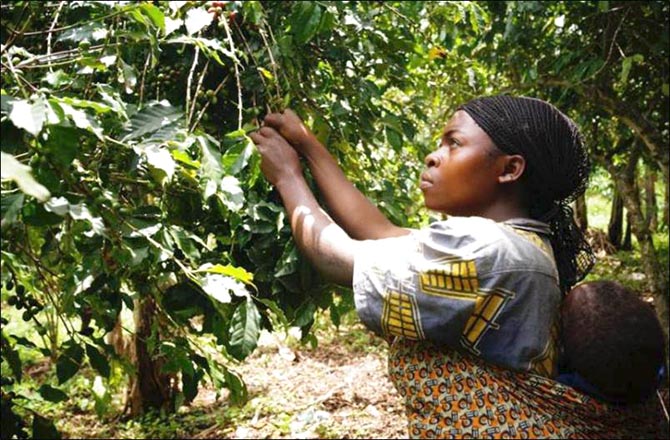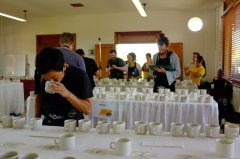Is there a G1 grade for the Ethiopian sun grading? Is there a G1 grade only for washing?

For professional baristas, please follow the coffee workshop (Wechat official account cafe_style)
Did you know that in Ethiopian coffee grading, G1 was first available only by washing? But now how to see more and more people start selling Ethiopian "sun" G1 coffee beans?
First of all, let's take a look at the grading of Ethiopian coffee beans. Before the implementation of the ECX trading system, Ethiopian coffee beans were graded according to the number of defective grains per 300g of raw beans, mainly divided into five grades. The latter defect rate is so high that buyers are basically not interested ~ so there is no need to mention XD). G1 indicates that there are only 0-3 defective beans per 300 grams of raw beans, G2 is 4-12 defective beans, and so on. Therefore, G1 is the highest level, while G5 is the lowest level for Ethiopian export.
Why is it that traditionally only raw beans treated with water have G1 grade? Let's talk about the process of traditional washing and sun treatment. There is a procedure for water separation of floating beans, that is, after putting raw beans into the water, the unripe beans float on the surface, and defective beans can be screened out accordingly. However, the traditional sun treatment is hand-picked, so it is difficult to completely rule out unripe beans, so the grade will start with G3.
In the past, sun-dried beans were regarded as a low-grade coffee treatment, and excellent varieties basically did not choose sun treatment. However, with the development of high-quality beans, the treatment method is also changing with each passing day. Ethiopian traditional solarization is baked on the ground, and with the assistance of foreign technology and the improvement of fermentation theory, the improved solarization is to put the fruit on a high shelf, breathable up and down, and carefully stirred in an artificial way to make the fermentation more uniform, so that the quality and flavor of sun-dried beans are getting better and better, so foreign buyers begin to require sun-dried beans to have G1 grades. Since the implementation of the ECX trading system in Ethiopia in 2009, the new grading system has been in use, with a G1~G5 rating for both tanning and washing. However, some sellers do not adapt to the new system, plus the higher the level, the heavier the tax, so there are still many sellers in order to avoid, take the traditional old classification method.
Although the sun has a G1 grade, it is still generally considered to have a lot of defective beans compared with water-washed floating beans. But in fact, we don't have to worry too much about this, because now small farmers will be required to choose coffee cherries more carefully before processing farms or cooperatives, so that they can check the front-end work first. On the other hand, defective beans have little influence on flavor, and the grading system can only be used to distinguish the proportion of defective beans, not the same as the advantages and disadvantages of flavor, so when you choose and buy coffee, in addition to referring to grading, don't forget to refer to the cup to measure the flavor spectrum!
Important Notice :
前街咖啡 FrontStreet Coffee has moved to new addredd:
FrontStreet Coffee Address: 315,Donghua East Road,GuangZhou
Tel:020 38364473
- Prev

Ethiopia's organic potential stock! The Guji producing area that is not inferior to Yega Xuefei.
For the exchange of professional baristas, please follow the coffee workshop (Wechat official account cafe_style). Before, we introduced Ethiopia's Yega Snow Coffee. Because of its special floral aroma and lemon and citrus flavors, it has become a target for international boutique coffee fans, which in turn has led to the increase of Ethiopia's domestic demand market. Under the circumstances that everyone is rushing to get it, the price of Yega Chevy can be imagined.
- Next

Coffee beans with frighteningly high altitude but low price-Colombian Coca Cup bidding beans
For the exchange of professional baristas, please pay attention to the coffee workshop (Wechat official account cafe_style). In addition to our common national-level competitions, such as Best of Panama in Panama or the COE Excellence Cup held by Central and South America, some producing areas will also hold regional competitions.
Related
- Detailed explanation of Jadeite planting Land in Panamanian Jadeite Manor introduction to the grading system of Jadeite competitive bidding, Red bid, Green bid and Rose Summer
- Story of Coffee planting in Brenka region of Costa Rica Stonehenge Manor anaerobic heavy honey treatment of flavor mouth
- What's on the barrel of Blue Mountain Coffee beans?
- Can American coffee also pull flowers? How to use hot American style to pull out a good-looking pattern?
- Can you make a cold extract with coffee beans? What is the right proportion for cold-extracted coffee formula?
- Indonesian PWN Gold Mandrine Coffee Origin Features Flavor How to Chong? Mandolin coffee is American.
- A brief introduction to the flavor characteristics of Brazilian yellow bourbon coffee beans
- What is the effect of different water quality on the flavor of cold-extracted coffee? What kind of water is best for brewing coffee?
- Why do you think of Rose Summer whenever you mention Panamanian coffee?
- Introduction to the characteristics of authentic blue mountain coffee bean producing areas? What is the CIB Coffee Authority in Jamaica?

